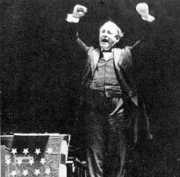This is a direct response to Ed’s post on the Gilded Age (the Guilded Age?). But rather than go at him personally, I think it better serves the broader question of the blog to air it publicly.
Just a sentence or two on the Populists? Bryan gets beat up in a minute! The Midwest gets nothing (a voice from Chicago here)? How can you get away with this! I feel like William Jennings Bryan.

Yes, we all skip tons in our surveys–by necessity. And I understand the virtues and costs of a more focused approach, of undercoverage. But it seems to work best for me when I think of the survey as a long three-part narrative, with the lectures unfolding from one to the next, the previous serving as an explanation for the one upcoming, and the story moving along, (mostly) chronological. Or something like that. This way I get coverage, but keep the narrative focus.
To explain with some specifics: the course is set up in three parts (1) Industrial America, 1865-1919ish; (2) “Modern” America, 1919-1945; and (3) our time, 1945-2011. I get between 8-10 lectures per section. And I work to make those lectures flow like a narrative.
For example, in Part 1, the root is the Industrial Revolution. One lecture on it. I then use it to explain the transformations in the North (one lecture on immigration and urbanization), the South (one lecture on the New South and Jim Crow) and the West (one lecture on the meaning of the West, its development, and the destruction of the Indians). Then I do a thing on the protests against the Industrial Order from the working class (one lecture on the early labor movement), the farmers and agrarian types–the Populists! (one lecture on Bryan and the Populists and the transformation of agriculture wrought by the Industrial Revolution), and the Progressives (one lecture–as we sit, literally, next to Hull House). Then we get to America’s increasing involvement in the world and World War I (one lecture on that). Then exam 1.
So we get a lot of coverage, but so much of it is connected to the root and the previous lectures that it begins to make sense to my students (at least I think it does). The only thematic odd ball here is Reconstruction. It’s hard to fit Reconstruction into the New South lecture and really difficult to fit it nicely in the “Industrial America” narrative–it works, I think, but it’s a stretch. Besides that, I find this a good narrative rubric that allows me to fit a lot in.
What gets left out? Still a ton. Religion is mostly quiet, although shows up briefly at the end of Reconstruction, in the labor movement, some of the west, and the Spanish-American War (yes, I said it). Aside from the concreting of domesticity, women don’t get a lot of attention until the Progressives. And any number of topics could be engaged in greater depth.
But I guess what I’m saying is I prefer the narrative approach over the shingled one. Maybe that’s just how my brain works, and probably some overlap of the two is best.
But you tell me: what am I doing wrong? How does your narrative flow?




I think one of the reasons I/we started this blog was so that my students would read and pay attention to that which I do not cover in the classroom lecture. The A students will read our discussions about WJ Bryan, will pay attention to it in HIST and Major Problems, and will learn who he is, why he’s important, etc., without me saying his name in class. For me, the blog and even our debates on teaching just add to the shingled, overlapping approach. Bryan’s gotta be the most beaten up figure in American history.
Ed, fair point. And your comment brings up another point that we haven’t yet engaged in (there are so many!). Should lectures be the garnish to the textbook, along with the readings we do in Major Problems? Or should it be the staple, with the Major Problems and other outside readings we do as the garnish?
In this, I guess it comes down to our expectations of our students–do we think they’ll get enough of the story from the textbook, or do we not trust them enough to do that on their own, and thus make the lecture another version of the textbook? I of course can’t answer that question for everyone, just suggest that my narrative approach mirrors the textbook while the shingled approach you describe uses the lecture for more penetrating analysis of the bigger, more important themes.
A conundrum, this one, and a good one to ponder.
Kevin, that’s a point I’m going to address today before discussion. Several students have asked a great question: how do I read? My Dad gave me great advice when I went to college: “if it matters to the professor, then it will matter on the exam.” I lived by that in college and it worked out pretty well (except for Biblical Hebrew, which killed my GPA). But today I’m going to work through how to read. I discuss this on my syllabus, but it appears students still have troubles with that. I can honestly say that no one explained to me how to read, how to focus on introductions, how to think about topic sentences, etc. Gordon Wood’s _Radicalism of the American Revolution_ taught me how to read!